American Indian/Alaska Native students represent an academically at-promise student group in California schools. These students are often neglected and underserved. Many factors contribute to the academic achievement gap that exists between American Indian/Alaska Native Students and their peers as a direct result of colonization, land theft, and genocide.
California is home to 109 federally recognized Indian tribes, including several tribes with lands that cross state boundaries. There are also approximately 81 tribes seeking federal recognition and more tribes in the state that are not pursuing federal recognition. The Relocation Act of 1956 brought between 60,000 and 70,000 out-of-state Native Americans into urban areas in California during the federal government’s efforts to assimilate Native Americans.
This web page provides information and resources related to American Indian/Alaska Native Students in California K-12 schools.
For program resource and information regarding the educational needs of American Indian/Alaska Native students please visit the American Indian Program web page.
American Indian/Alaska Native Student Identification
The U.S. Department of Education (ED) sets federal education eligibility requirements for identification and accountability reporting standards. The California Department of Education (CDE) also requires local educational agencies (LEAs) and schools to collect and report data consistent with these federal requirements. Identification of students requires that a two-part question is used to collect data about students race and ethnicity.
The first part asks respondents to select their ethnicity:
- Hispanic or Latino
- Not Hispanic or Latino
The second part asks respondents to select one or more races from the following categories:
- American Indian/Alaska Native
- Asian
- Black or African American
- Native Hawaiian or Other Pacific Islander
- White
The definition for American Indian/Alaska Native used by CDE is consistent with the federal Office of Management and Budget (OMB) 1997 standards as a person having origins in any of the original peoples of North and South America (including Central America), and who maintains tribal affiliation or community attachment.
Federal policy on race and ethnicity data collection and reporting requirements creates four basic race/ethnicity categories.
- American Indian/Alaska Native - Non-Hispanic
- American Indian/Alaska Native - Hispanic
- Two or More Races - non-Hispanic
- Two or More Races - Hispanic
Only students identified as American Indian/Alaska Native Non-Hispanic are included in the American Indian/Alaska Native student group on the California School Dashboard and DataQuest reports. American Indian/Alaska Native - Hispanic and Two or More Races - Hispanic students appear in the Hispanic category on these reports and American Indian/Alaska Native students who are of two or more races are reported as Two or More Races.
American Indian/Alaska Native Student Identification Categories
The table below shows information on how American Indian/Alaska Native students self-identify, the relationship to the federal definition (American Indian/Alaska Native), the inclusion of students for federal grants, the inclusion of students towards tribal consultation requirements, and information on whether a student is included in DataQuest reports and the California School Dashboard as American Indian/Alaska Native. The descriptor for each * pertains to specific columns on the table.
*The definition for American Indian/Alaska Native used by CDE is consistent with the federal OMB 1997 standards as a person having origins in any of the original peoples of North and South America (including Central America) and who maintains tribal affiliation or community attachment.
** Students are eligible to enroll in the Title VI Indian Education Program if the student and his/her parent(s) or grandparent(s) are enrolled member of an American Indian/Alaska Native tribe or if the student, parent(s), or grandparent(s) have a Certificate of Degree of Indian Blood.
***The OMB 1997 definition is used by LEAs to collect student demographic information. This count is used to determine the Tribal Consultation requirement under Section 8538 of the Elementary and Secondary Education Act (ESEA), as amended by the Every Student Succeeds Act (ESSA), an affected local educational agency (LEA) is one that either:
- received a Title VI Indian Education formula grant in the previous fiscal year that exceeds $40,000;
- or, has 50 percent or more of its student enrollment made up of American Indian/Alaska Native students.
Use of the OMB 1997 definition, in relation to Tribal Consultation requirement, creates challenges when determining whether an LEA has 50 percent or more of its enrollment made up of American Indian/Alaska Native students. The use of the OMB 1997 definition results in students who have connections to any of the original peoples of Central and South America being included in the American Indian/Alaska Native count. This could lead to an overcount of students in their American Indian/Alaska Native count for purposes of Tribal Consultation. The total American Indian/Alaska Native enrollment data should only include, for the Tribal Consultation requirement, those students who self-identify as American Indian/Alaska Native alone and American Indian/Alaska Native in combination with one or more races, regardless of Hispanic ethnicity. The count should not include students who identify as originating from Central or South America.
| Category |
Federal Definition - American Indian/Alaska Native* |
Title VI Indian Education Formula Grant** |
Tribal Consultation Requirement*** |
Displayed on DataQuest and California School Dashboard as American Indian/Alaska Native |
Self-Identified Federally Recognized and Unrecognized
American Indian/Alaska Native
|
Yes |
No |
Yes |
Dependent on individual responses to Ethnicity and Race Questions |
| Central & South American Indian |
Yes |
No |
No |
Dependent on individual responses to Ethnicity and Race Questions |
| Students with Federally Recognized Tribal Enrollment |
Yes |
Yes |
Yes |
Dependent on individual responses to Ethnicity and Race Questions |
Self-Identified during enrollment in LEA as:
Ethnicity: Non-Hispanic
Race: American Indian/Alaska Native |
Yes |
No |
Yes |
Yes |
Self-Identified during enrollment in LEA as:
Ethnicity: Hispanic
Race: American Indian/Alaska Native |
Yes |
No |
Yes |
No |
Self-Identified during enrollment in LEA as:
Ethnicity: Non-Hispanic
Race: American Indian/Alaska Native and another Race (Two or More Races) |
Yes |
No |
Yes |
No |
Self-Identified during enrollment in LEA as:
Ethnicity: Hispanic
Race: American Indian/Alaska Native and another Race (Two or More Races) |
Yes |
No |
Yes |
No |
Information can be found on DataQuest and the California School Dashboard which display American Indian/Alaska Native data for those students who self-identified as:
which display American Indian/Alaska Native data for those students who self-identified as:
- Ethnicity: Non-Hispanic
- Race: American Indian/Alaska Native
The table below shows the primary enrollment information for variations of students who identified as American Indian/Alaska Native.
2022-23 Enrollment Data for American Indian/Alaska Native Students Including Hispanic Ethnicity and Two or More Races
| Enrollment |
American Indian/Alaska native - Only |
American Indian/Alaska Native
and Two or More Races |
American Indian/Alaska Native
and Hispanic
or Hispanic and
Two or More Races |
Total |
| 2022-23 |
26,106 |
35,187 |
327,400 |
388,693 |
The California Longitudinal Pupil Achievement Data System (CALPADS) is a longitudinal data system used to maintain individual-level data including student demographics, course completion, discipline, assessments, staff assignments, and more for state and federal reporting. Student data is collected by LEAs and then reported to the CDE through CALPADS. Information about the data collected by CALPADS and Frequently Asked Questions (FAQ) can be found on the CALPADS Frequently Asked Questions web page.
Native American/Alaska Native Students Quick Facts
The table below provides primary and secondary enrollment counts for various student groups including American Indian/Alaska Native students.
2022-23 Statewide Enrollment by Race/Ethnicity
| Race/Ethnicity |
Enrollment |
Percentage |
| African American |
273,148 |
4.7% |
American Indian/Alaska Native |
26,108 |
0.4% |
| Asian |
557,190 |
9.5% |
| Filipino |
127,735 |
2.2% |
| Hispanic or Latino |
3,284,788 |
56.1% |
| Pacific Islander |
23,847 |
0.4% |
| White |
1,175,911 |
20.1% |
| Two or More Races |
252,400 |
4.3% |
| Not Reported |
131,417 |
2.2% |
| Total |
5,852,544 |
100% |
Federal policy on race and ethnicity data collection and reporting requirements creates four basic race/ethnicity categories.
- American Indian/Alaska Native - Non-Hispanic
- American Indian/Alaska Native - Hispanic
- Two or More Races - non-Hispanic
- Two or More Races - Hispanic
Only students identified as American Indian/Alaska Native Non-Hispanic are included in the American Indian/Alaska Native student group on the California School Dashboard and DataQuest reports. American Indian/Alaska Native - Hispanic and Two or More Races - Hispanic students appear in the Hispanic category on these reports and American Indian/Alaska Native students who are of two or more races are reported as Two or More Races.
For more information on annual enrollment and downloadable data files visit the Annual Enrollment Data web page.
American Indian/Alaska Native Student Data & Outcomes
American Indian/Alaska Native youth are identified by Local Education Agencies (LEAs) in their enrollment process and provided to the California Longitudinal Pupil Achievement Data System (CALPADS). The definition for American Indian/Alaska Native student used by LEAs when collecting data is consistent with the federal Office of Management and Budget (OMB) 1997 standards as a person having origins in any of the original peoples of North and South America (including Central America), and who maintains tribal affiliation or community attachment.
State Level Educational Outcomes of American Indian/Alaska Native Students
The outcomes for American Indian/Alaska Native students, outlined below, are published annually. These outcomes and more can be accessed on DataQuest. DataQuest is the California Department of Education’s (CDE's) online, public reporting system that provides reports about California’s schools and school districts.
The student data found on DataQuest and the California School Dashboard displays American Indian/Alaska Native data for those students who self-identified as:
displays American Indian/Alaska Native data for those students who self-identified as:
- Ethnicity: Non-Hispanic
- Race: American Indian/Alaska Native
2021–2022 Percent of Students Chronically Absent
Chronic absence rate is calculated as the percent of students who miss 10 percent or more of the days they are expected to attend school. In the 2021–22 school year, 43.6 percent of American Indian/Alaska Native students in grades kindergarten through twelve were chronically absent compared to a rate of 30 percent for all students. Chronic Absenteeism reports are available through DataQuest.

2021–2022 Suspension Rate
Suspension rate is calculated as the percent of all students who were suspended one or more times during the school year for an in-school or out-of-school suspension. In the 2021–22 school year, 6.5 percent of American Indian/Alaska Native students were suspended for at least one day compared to a rate of 3.2 percent for all students. Suspension reports can be accessed through DataQuest.
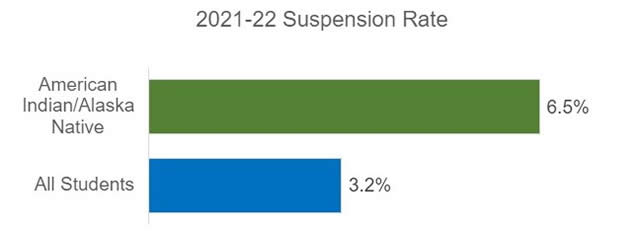
2021–2022 Four-Year Adjusted Cohort Graduation Rate
The four-year adjusted cohort graduation rate is calculated as the percent of students who graduate high school within four years from the time they enter ninth grade with a traditional high school diploma. The four-year cohort is based on the number of students who enter ninth grade for the first time adjusted by adding into the cohort any student who transfers in later during ninth grade or during the next three years and subtracting any student from the cohort who transfers out, emigrates to another country, transfers to a prison or juvenile facility, or dies during that same period. In the 2021–22 school year, 78.8 percent of American Indian/Alaska Native students graduated compared to a rate of 87 percent for all students. Four-Year Adjusted Cohort Graduation reports can be accessed through DataQuest.

2021–2022 School Stability Rates
The stability rates are from a report that provides a total count of cumulatively enrolled students with an enrollment start date on or after July 1 and on or before June 30 (Adjusted Cumulative Enrollment), a count of students identified as part of the Stability Count (i.e., students with stable enrollments), and a count of students identified as part of the Non-Stability Count (i.e., students without stable enrollments). Students are determined to have a “stable” enrollment during the academic year if the enrollment record is a minimum of 245 consecutive calendar days at the same school without a disqualifying exit. The Adjusted Cumulative Enrollment along with the Stability and Non-Stability Count are used to calculate the Stability Rate (Stability Count divided by the Adjusted Cumulative Enrollment) and the Non-Stability Rate (Non-Stability Count divided by the Adjusted Cumulative Enrollment) at the selected entity for the selected population using the available filters. In the 2021–22 school year, 84.5 percent of American Indian/Alaska Native students had a stable enrollment compared to a rate of 89.8 percent for all students. This report is available through DataQuest.

Federal policy on race and ethnicity data collection and reporting requirements creates four basic race/ethnicity categories.
- American Indian/Alaska Native - Non-Hispanic
- American Indian/Alaska Native - Hispanic
- Two or More Races - non-Hispanic
- Two or More Races - Hispanic
Only students identified as American Indian/Alaska Native Non-Hispanic are included in the American Indian/Alaska Native student group on the California School Dashboard and DataQuest reports. American Indian/Alaska Native - Hispanic and Two or More Races - Hispanic students appear in the Hispanic category on these reports and American Indian/Alaska Native students who are of two or more races are reported as Two or More Races.
Statewide Accountability for American Indian/Alaska Native Students
The latest statewide accountability indicators for American Indian/Alaska Native students.

California's accountability system is a multiple measures system that assesses how local educational agencies (LEAs) and schools are meeting the needs of their students. Performance on these measures is reported through the California School Dashboard (Dashboard).
(Dashboard).
For the past two years, many state and federal accountability requirements were waived or adjusted due to the impact of the COVID-19 pandemic on LEAs, schools, and students. Beginning with the 2021–22 school year, the requirements to hold schools and districts accountable for student outcomes has returned with the release of the 2022 Dashboard.
The Every Student Succeeds Act requires all states to determine schools eligible for support. Similarly, under state law, Assembly Bill (AB) 130, which was signed into law in 2021, mandated the return of the Dashboard using only current year performance data to determine LEAs for support. Therefore, compared to prior Dashboards, the 2022 Dashboard does not report Change (or the difference from the prior year) and performance levels using colors. Instead, performance levels for all state indicators are reported using one of five Status levels ranging from Very High, High, Medium, Low, and Very Low), which are based on the 2021–22 school year data.
The 2022 accountability measures and historical American Indian/Alaska Native student performance can be found on the California School Dashboard .
.
For more information, resources, and guidance for the Dashboard and System of Support, please visit the California School Dashboard and System of Support web page.
English Language Arts
This measure of the Academic Performance state indicator reports student progress on the statewide assessment for English Language Arts/Literacy. It uses the Smarter Balanced Summative Assessments and California Alternate Assessments, and it is calculated based on the average "Distance from Standard" for all students in grades 3 through 8 and/or grade 11. For the 2022 Dashboard, American Indian/Alaska Native students have a status level of Low and scored 49.3 points below standard compared to the statewide average of 12.2 points below standard and a status of Low for all students. This data is available on the Dashboard .
.
Number of Students: 13,114
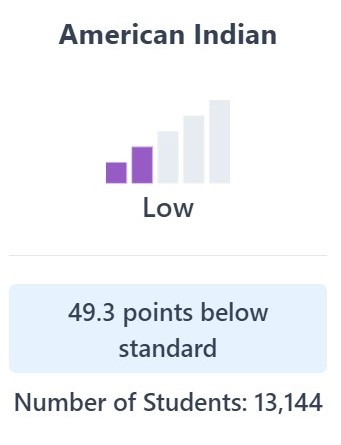
Mathematics
This measure of the Academic Performance state indicator reports student progress on the statewide assessment for mathematics. It uses the Smarter Balanced Summative Assessments and California Alternate Assessments, and it is calculated based on the average "Distance from Standard" for all students in grades 3 through 8 and/or grade 11. For the 2022 Dashboard, American Indian/Alaska Native students have a status level of Low and scored 90.4 points below standard compared to the statewide average of 51.7 points below standard and status level of Low for all students. This data is available on the Dashboard .
.
Number of Students: 13,132
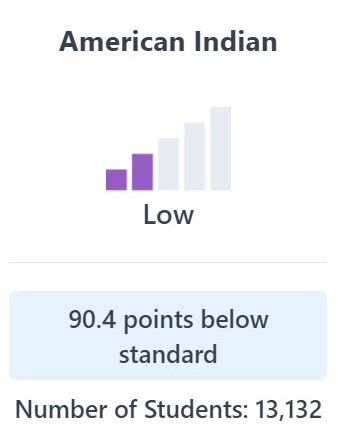
Chronic Absenteeism
The Chronic Absenteeism state indicator shows how many students in grades kindergarten through 8 who were absent for 10 percent or more of the total instructional school days each student was expected to attend. American Indian/Alaska Native Students have a status level of Very High. For the 2022 Dashboard, American Indian/Alaska Native students in grades kindergarten through 8 were chronically absent 42.9 percent compared to the statewide rate of 30 percent and a status level of Very High for all students. This data is available on the Dashboard .
.
Number of Students: 17,662
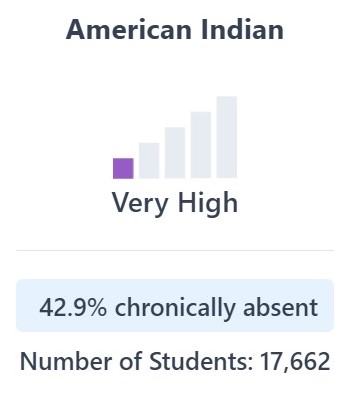
Graduation Rate
The Graduation Rate state indicator reflects the percentage of students who graduate with a regular high school diploma in four years or five years. American Indian/Alaska Native students have a status level of Low. For the 2022 Dashboard, 79.6 percent of American Indian/Alaska Native students graduated compared to the statewide rate of 87.4 percent and status level of Medium for all students. This data is available on the Dashboard .
.
Number of Students: 2,690
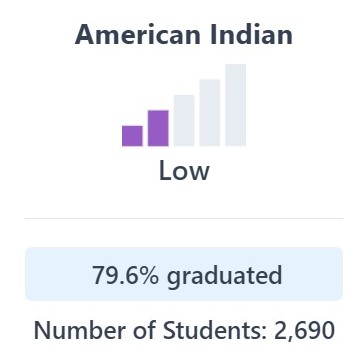
Suspension Rate
The Suspension Rate state indicator reflects the percentage of students in kindergarten through grade 12 who have been suspended at least once in a given school year. Students who are suspended multiple times are only counted once. American Indian/Alaska Native students have a status level of High. For the 2022 Dashboard, 6.4 percent of the American Indian/Alaska Native students were suspended for at least one day compared to the statewide rate of 3.1 percent and status level of Medium for all students. This data is available on the Dashboard .
.
Number of Students: 27,969

Federal policy on race and ethnicity data collection and reporting requirements creates four basic race/ethnicity categories.
- American Indian/Alaska Native - Non-Hispanic
- American Indian/Alaska Native - Hispanic
- Two or More Races - non-Hispanic
- Two or More Races - Hispanic
Only students identified as American Indian/Alaska Native Non-Hispanic are included in the American Indian/Alaska Native student group on the California School Dashboard and DataQuest reports. American Indian/Alaska Native - Hispanic and Two or More Races - Hispanic students appear in the Hispanic category on these reports and American Indian/Alaska Native students who are of two or more races are reported as Two or More Races.
![]() which display American Indian/Alaska Native data for those students who self-identified as:
which display American Indian/Alaska Native data for those students who self-identified as:









